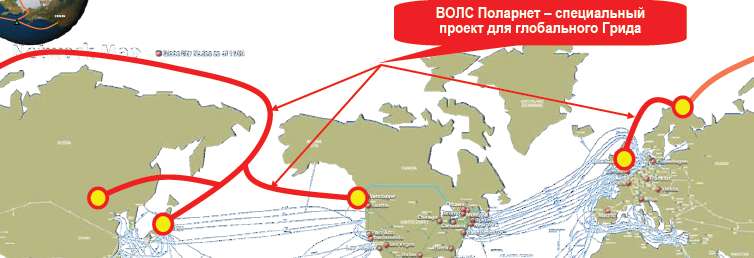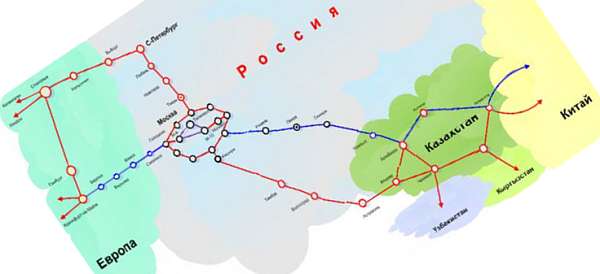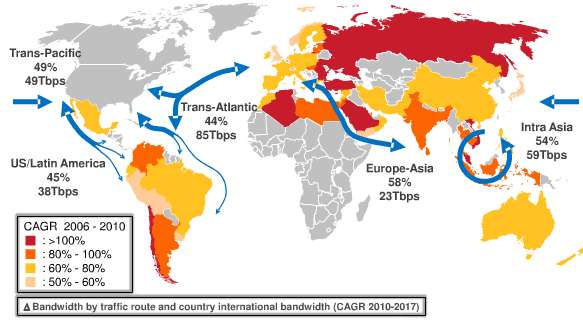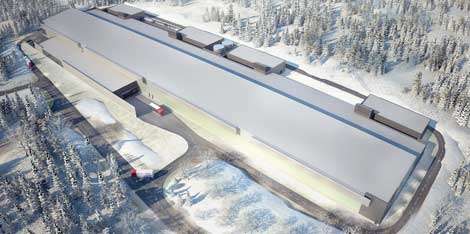This is a guest post by Egor Drobyshev, who writes about telecommunications in Russia. It is translated from its original version in Russian here.
It is obviously impossible to underestimate a value of The Silk Road, which had connected in the second century both East and West civilizations. It was the first transcontinental route in the history of the humanity able to adjust trading from the walls of the ancient Rome up to Japanese shores. Moreover, European knowledge about charming Chinese silk was completely down to The Road. However, there is a world of difference nowadays: in the post-industrial society an article of trade has turned out to be a message transfer to long distances. Even at the beginning of telecommunication development there was not any opportunity to turn a blind eye to the fact, that Russia, which had been “holding a shield between two hostile races, Mongols and Europe” (Alexander Blok, “The Scythians”) since olden times, occupied an advantageous geographical position.
In due time fifty miles of Bering Strait’s water place, chain of Aleutian Islands and Siberia has inspired America as well as Eurasia on creation “Western Union Extension C” society in order to integrate their cable network. According to the contract, signed on the 9 of March 1865, Americans had been ought to establish a telegraph line from their own possessions to the city of Nikolaevsk at the mouth of Amur. Then the tsarist government of Russia was in charge of message transmission. Frankly, the project, having passed no telegrams, was closed. The objective of conjunction between the Europe and US was successfully solved by “The Great Eastern” and S. V. Field up to deadline. On the 27 of July 1866 work on laying the first cable across the Atlantic ended up with success. The hope of “Western Union Extension C” on the monopoly of telegraphic communication between Europe and America had not been realized. (“The History of Telecommunications of the Russian Empire“, M. S. Visokov, p.226-228).
In modern Russia the history of transit between Europe and Asia originate from times of Perestroika, when creation of mobile communication was down to the Trans-Soviet Line (TSL) project despite this irony of fate. The project was concerned laying a fiber-optic line from the West of Europe and Kaliningrad to Nakhodka and then South Korea with Japan. Who knew, how would have “fell cards” in today’s layout of traffic on the route from Asia to Europe, if CoCom had allowed a delivery of equipment in Russia? At that time systems of handing over able to allow 140 Mbps on the fiber were assumed to be know-how. US West, a foreign partner of the project, was concerned it would be nonsensical to use less productive ones. Unfortunately, it is impossible to make time reverse in order to achieve comeback in “yesterday”, because “the history do not know a conjunctive mood” (I.V. Stalin, on the ground of Karl Hampe statement «Die Geschichte kennt kein Wenn», which direct interpretation is “History do not now If”).
Again the transition between Europe and Asia was at the top of discussion only in the new millennium. By that time, The Napster network had already managed to born, become a bright star, by discovering a charm of peer-to-peer to the world and collapse under the pressure of copyright holders. But, on the other hand, it’s successors who were more luckily, i.e. decentralized, and were quickly named “nets’ killers” by providers, in reason of their ability to “eat up” the bandwidth of any capacity. In backbone networks the Internet was firmly established as a major source of demand by band, while the growth of broadband access in Asia having come out in highly populated countries of the region had attracted the attention of a great number of providers. In 2001 band on international directions for Internet traffic in general was devoted to Japan and South Korea, whereas in 2006 an important role was occupied by China, Malaysia, and Taiwan. During this time the band for the Europe-Asia IP-transit has increased from 357M to 24,5 Gbps. Nevertheless, to compare in 2006 the band for IP-transit from North America was reckoned up for 668, 307 and 100 Gbps in proportion to Europe, Asia and Latin America, i.e. much bigger.
Global Internet Map: 2001 and 2006 year, TeleGeography
Once more the idea of Russian Europe-Asia route had been widely discussed since 2002-2003, when an amount of valuable announcement was made. In addition to Rostelecom, where entering into operation digital radio-relay link Moscow-Khabarovsk “the telecom ring was closed” as well as the world’s one were added such projects as “FTA Enterprises”, Polarnet and “Eurasia Telecom”. All three companies supposed to use the beneficial geographical position of Russia, although each of them has chosen its own way in this walk of life. Fiber Trans-Asian (FTA) global network suggested getting from Sweden into China through Latvia, Russia and Kazakhstan, on the Russian territory, exactly along the transmission lines of RAO “UES of Russia”. “Eurasia Telecom” has also chosen an overland path, which, firstly and lastly, involved Moscow, Saint-Petersburg, Tver and Novgorod.
The Polarnet made up its mind to use another north path with a purpose to bind Europe, Asia and America, promoting the grid-computing idea, which having overtaken the time of “cloud computing”, had “entering into” the world of IT and telecom slightly later. Underwater cable system had to pass the route London – Quirkiness (Norway) – North Sea of Russian economic zone – Dutch Harbor (Aleutian Islands, USA) and then two branches, one on Chiba (Japan) and Shanghai (China) and the second on Portland (USA).
The project of Polarnet: Grid’s global system infrastructure
Later, as “a rare bird that can fly to the middle of the Dnieper” (Nikolai Gogol, “A terrible vengeance”), thus a rare year managed to pass without a theme’s of transit between Europe and Asia surfacing. Of course, coupled to Rostelecom, it was no opportunity to dispense with the second and the first-rate highway provider in Russia – Transtelecom (TTK). In spite of the fact, that FTA, Polarnet and Eurasia Telecom did not enter a market of transit, the other two companies, Rostelecom and Transtelecom, had enough reasons to declare itself in the press. The deal was too great and too enormous. Agreements were accepted, the border crossings were under construction and introduced into the system, agreements on cooperation were signed; the networks were upgraded and preparing to take the traffic.
Other companies had been occasionally rushing in the pursuit of income, which the illusions of the Silk Road offered. And nowadays rush. Only last year, when SvyazDorInvest entered the market with the project “Eureka”, where with the assistance of the state corporation Russian Technologies it was planned to build its own backbone network along roads in two years. Frankly, the deadlines have been missed and rearranged this year. If in 2010 it was thought to launch the network in 2012, today the first stage of the project would start working only in the beginning of 2013, while the construction on Russian territory would be completed by 2014. The system capacity will be 3,2 Tbps (80 channels of 40 Gbps), and the delay in the network will be 50 milliseconds. If only it was clear how and where…
The scheme of fiber-optical route Europe – Russia – China, from the description of project “Eureka” (belonging to the document SvyazDorInvest unknown)
There is only a one insignificant nuance in this conception of transit between Europe and Asia. Despite of all obvious advantages of surface route through Russia, such as rapid repairing, short delay, what is more, they say about reservation last time. However, Rostelekom and TTK, the two most powerful companies, were not able to create a furor. There were scores of promises and declarations to win at least 30% of traffic, nevertheless, the traffic use to move through America, at the bottom of the Pacific ocean or through Egypt, bypassing Indian ocean. What prevents it from running through Russia is impossible to understand.
Many believe that Russian providers are not taking seriously in the world arena. If we return to 2005, we’ll find that a transit route from Europe to Asia in Russia seemed to lots of people to be a breathtaking adventure, exciting, funny, intriguing adventure with little part of adrenalin.
“Russia, however, now offers a reliable low-latency alternative to the Asia-to-Europe undersea cables. So Jim Cowie (our CTO) and I went to Moscow to see what was happening. Meeting with some of our Russian backbone providers was interesting, of course, but their travel tips for a couple of out-of-towners were really interesting. The first thing we tried was a high-end cab billed directly to our hotel. We slipped into a sleek Mercedes commanded by a steely-eyed Cossack in a trim grey suit. Our driver knew no fear. Obstacles in our path — mere trifles», Internet Transit Sales: 2005-10 (Bob Fletcher).
Of course, there is a part of truth in these words. The capacity of Russian route whether Rostelecom or Transtelecom in comparison with other routes is incredibly small. “TTK increased the main capacity, which was reserved for the euro-asian transit, up to 110 Gbps in 2009”,- Comnews, “Backbone networks rose on the Silk Road”. The capacity 1334 Gbps was used in 2010 on the route Europe-Asia, even avoiding underwater cable systems, that were brought into operation, the difference is up to 10 times. How we can speak about the limit of the market? It’s critical to have necessary dimension of capacity to be the number one brand on the market. Moreover, it is desirable to have a needed reserve. Can a SvyazDorInvest become a strong competitor on the market with its project «Eureka» with only 3,2 Tbps, that is going to start in 2017, taking into account all delays and time that is needed to get ready?
International Bandwidth Growth 2010 – 2017, TeleGeography
However, the major problems are connected with the coordination of action between Russian and their colleagues from the other side of the board, Chinese. As usual, lots of questions appear on the networks junction, beginning with the simplest: how much will it cost for one country to use the route that is situated on the territory of the other country? So, Russian providers now can just hope for the bonus services, suggesting entice clients by the low delay, so vital, where people make money for every minute, money, money and money again. It lasts every moment, when a new millisecond comes to the world. However, it shouldn’t belittle a tradition in any case. As usual, somebody raises the topic of Europe- Asia transit in Russia every year, what is more, it’s even better to announce about a new project. Of course, the current year is not an
exception. In a present – day round Polarnet took the place on a podium again.
Today the route of the Russian Trans-Arctic Cable System (RUTACS) is planning to link Europe and Asia on the route Bude (The Great Britain) – Murmansk – Anadyr –Vladivostok – Tokyo. Except struggle fight for the transit there are such questions as developing Arctic and safeguarding national security among the major problems. It is needed to say that stake on Arctic can prove its value. As we all know it is quite rich, not only with minerals but there is another one significant natural resource – heavy and cold climate. For an example, Facebook decided to place their services on the North, chose small town Lulea in Sweden for building their first datacenter abroad USA, where an average temperature is only about two degrees above zero. It will allow to make a system of cooling cheaper.
Facebook Goes Global With Data Center in Sweden, Data Center Knowledge
Is Anadyr worse than Lulea? Even in a warm season temperature there does not go upper than 18,8 above zero, as for winter, an average temperature is only 7,4 below zero, so it’s possible even to heat buildings there. It’s needed just to add energy to the local power plant or to build a new tidal station, to give a name to a project on a green stamps special for West. Why it cannot be a new national project? If it happens Anadyr will be a new telecommunication capital of Russia, where an Internet now is about 100$ per every gigabyte, and it’s the best price! The only problem is the particle “if”…
If you haven't already, please take our Reader Survey! Just 3 questions to help us better understand who is reading Telecom Ramblings so we can serve you better!
Categories: Guest Posts · Internet Backbones










It reads a little like a Google Translation of the original text, that makes it hard to read. This is disappointing because there are some interesting (if somewhat partisan) ideas explored here.
agreed, would be much more readable if a human translated it.
So much potential on such a link, yet there’s never any substantial action…
The Russian/Chinese operators only have themselves to blame for that, charging what they do for capacity Europe to Asia. A 3-4x premium over the longer way round is not attractive, it just makes for a niche market.
CT now says they will shortly launch a longer terrestrial route (200-210ms?) at pricing parity with subsea options. When you tell them the market price for capacity on the subsea route, they don’t believe you. Result, nothing is going to change.